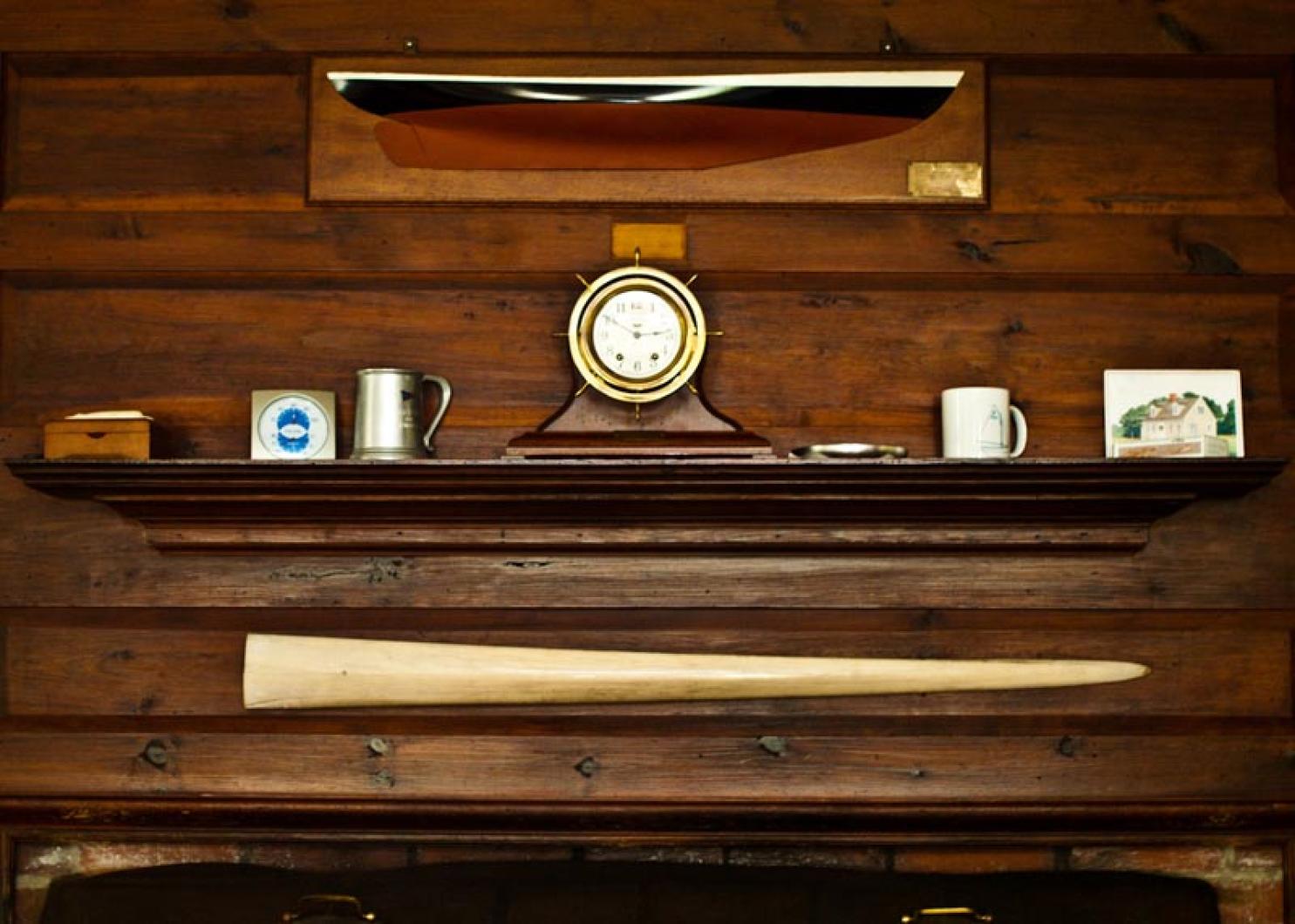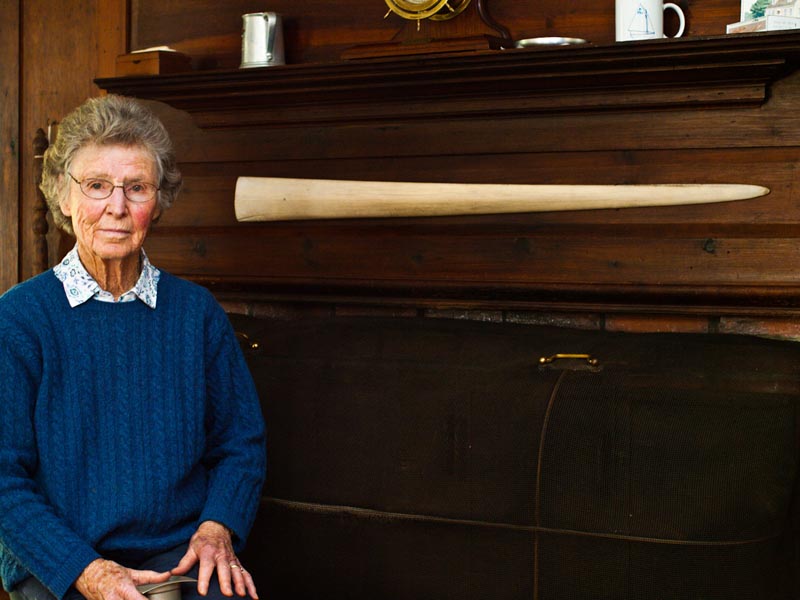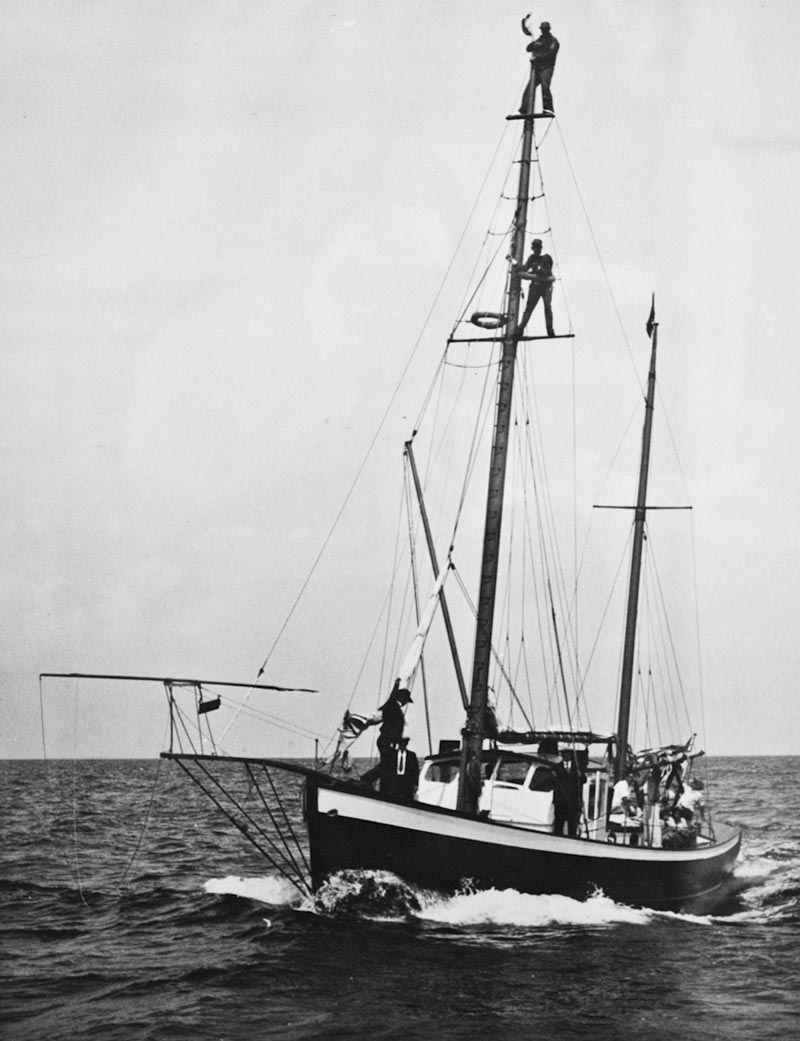The film is just 23 minutes, 14 seconds long. It’s silent, black and white and there are moments when the images jump around due to the choppiness of the sea — or of the editing.
There’s a shot of a man with a long harpoon and dart leaning against the rail of a bowsprit. There’s a wooden keg bouncing over the wave tops toward the horizon after the harpooner has struck his prey. There’s the great fish with the long bill shivering as the fishermen haul it onto the deck and dress it for market.
Photographed sometime between the summers of 1935 and 1938 by Charles A. Welch of Chappaquiddick and his cameraman Morgan Plummer, these scenes are the oldest known moving images of Island men swordfishing by harpoon on the Atlantic waters south of Martha’s Vineyard. It’s a home movie from a lost epoch, footage that may never be shot in this corner of the world again.
It is also a dramatic and previously unknown record of how a recreational fisherman and his crewmen pursued a prized game fish in what was still a time of ocean plenty more than 75 years ago, chasing and harpooning swordfish one by one in the spirit of a real, offshore hunt.
These scenes were shot decades before the technique of longlining swept much of the North and South Atlantic of the largest sorts of swordfish seen in this film. It is therefore an important artifact of Island history and a record of a way of fishing hardly ever practiced in the waters around us today.
With this film — titled Sword Fishing South of Martha’s Vineyard — the Gazette embarks on a special project to identify and oversee the conservation of old movies of Martha’s Vineyard and reintroduce them to the public. A clip from the swordfishing film appears in the multimedia section of this website.
Charlie Welch, from whose motorsailer these scenes were filmed, worked in a family investment firm in Boston before he and his wife Ruth, both of Marblehead, bought 100 acres of land on Chappaquiddick in 1928, known then and now as Pimpneymouse Farm. Mr. Welch was a peripatetic outdoorsman, jumping from one avocation to another — duck hunting, farming, ocean racing and, in this film, harpooning swordfish.
“He had so much energy,” said his daughter Edith W. Potter, who lives on the farm with her husband Robert and continues to work it today. “He threw himself into things.” When hunting swordfish became a calling, Mr. Welch asked L. Francis Herreshoff — a great marine architect, author and family friend — to design the handsome, high-sided, seagoing motorsailer named Walrus, seen in the film.
In the movie, we briefly glimpse a famous Woods Hole fish market known as Sam Cahoon’s, which stood just west of what is now the Steamship Authority wharf, and from which boats loaded ice for their fishing trips. The Walrus, which measured 50 feet and carried more than 7,000 square feet of sail primarily to help steady her in a heavy sea, is soon seen on the Atlantic south of the Vineyard, her course traced on a map at the start of the movie.
“She was state of the art,” said S. Bailey Norton, who watched the film recently at his home in Edgartown and worked aboard the boat as a boy.
“My job on the Walrus — she had two large Lathrop engines; they were probably straight, in-line, six or eight cylinder — they were very fussy about keeping stuff clean,” Mr. Norton said. “After they came home from a trip, they would go down below with a squirt can of gasoline and a piece of waste and wipe all the oil off the engines. They gave me that job. Other times I’d help shine brass. No chrome or stainless. Everything was brass.”
At sea, we see crewmen climb the tall mainmast to look for the telltale wake of a dorsal fin and tail cutting across the water below them. Sailing with Mr. Potter were employees and friends from Edgartown and Chappy who worked on the farm, aboard the boat or both.
Among the crewmen identified in the film by Mr. Norton and Mrs. Potter are Frank Drake and Roy Willoughby; a third may be Oscar R. Johanson, a jack-of-all-trades on Chappy and a fourth Leon H. (Jiggs) Easterbrooks, a noted Edgartown commercial fisherman and co-founder (with Bailey Norton’s uncle Philip B. Norton) of the boatyard known as Norton and Easterbrooks then and Edgartown Marine today.
Intercut with titles (“Rigging up and striking a Fish”), the footage quickly introduces the viewer to the main features of the hunt — a crewman at the bow, guiding the helmsman toward the fish with hand gestures; the harpooner in the bowsprit, checking the line that fixes the dart to the pole; and a wooden keg racing off toward the horizon with the harpooned swordfish somewhere below, struggling to get away.
In just a few moments, a wooden dory is alongside the fish and a crewman is lancing it.
“That’s pretty well ironed,” said Capt. Greg Mayhew, who watched the film with his son Todd aboard the fishing vessel Unicorn in Menemsha recently. Captain Mayhew harpooned his first swordfish in 1961, when he was 16, and reckons that he may have harpooned more swordfish than any man now living in North America — more than 3,000. His record within sight of the Vineyard was harpooning 19 in one day in the early 1980s.
“It’s right up by the dorsal fin,” said Captain Mayhew of the place where the harpoon struck. “That’s a good spot. You lance it to bleed the fish. That’s what he’s doing there — see how he’s stabbing? The only problem with that is if the main ship isn’t ready to pick you up, it attracts sharks.
“Now he’s tying off the fluke,” he said, as the crewman lashes the tail to keep the fish afloat next to the dory, which bobs sharply in the chop. “Because they didn’t have radios, you took the oar, you waved it. That means either you got it or you lost it.” A crewman didn’t have specific signals for success or failure, Captain Mayhew said, because the mother ship “might not pick you up for a while if you lost it.”
The Walrus looms up to the dory and soon the men are hauling the swordfish onto the deck using blocks and lines. Not including the sword, the fish is at least eight feet long and, Captain Mayhew guessed, more than 220 pounds. The next title card — “Trimming” — shows the men cutting off the sword and fins, eviscerating the guts and washing down the meat with buckets of saltwater before icing it in the hold.
There are brutal moments in this footage, reflective of a different time environmentally.
At one point the men catch what they identify as a blue shark — though the sun washes out some of the photography, and Captain Mayhew thought it might actually be a mako — cut away its jaw and send the rest of the animal back into the sea while still alive. Likewise, they behead a living sea turtle, a sequence that the title card calls “A shift in the menu, green turtle soup.”
Interspersed with these unlovely scenes are more whimsical moments — shots of an exhausted songbird hopping around the deck, its only plausible landing place so far out to sea; a richly varnished motor launch roaring by, her passengers dressed in 1930s finery; and fishing smacks shouldering along the horizon under both power and sail.
All told, the film shows the capture and trimming of at least seven swordfish, one possibly weighing as much as 300 pounds, during what may be two or three different trips, given changes in the sea conditions. There are scenes of the men fishing for tuna by rod and reel, attempts to catch swordfish with a newfangled harpoon gun, and an impressive moment when a crewman slides down a stay from the mast top, grabs a harpoon, and strikes a fish in just two or three seconds.
It ends with majestic footage, shot by a skilled cameraman high up in the mast, looking down on the deck of the Walrus as she thunders homeward to Edgartown, her two dories jigging along behind her. Entering Edgartown, there is a breathtaking shot of the old lighthouse sliding by, its sqaurish keeper’s dwelling supporting the light on its roof, both soon to be lost in the Hurricane of 1938.
In the decades since this film was shot, the modern practice of long-lining swordfish — hooking them indiscriminately behind a fishing boat using barbed lines as much as 30 miles long — has imperiled the stock, though the federal government today limits longlining in certain ways and now declares the species recovered, according to Captain Mayhew.
Even so, hunting and harpooning individual, mature fish one at a time is all but unknown in American waters in 2012. Captain Mayhew said he last harpooned a swordfish on Georges Banks in 2006. He said that in summer, there are still far fewer large swordfish south of the Island than there were when he was young.
Art Donahue, a film and video technician in Franklin, transferred the eight-millimeter swordfishing film to a digital format late last year, along with other Welch and Potter family films dating to the late 1920s in Edgartown. John Wilson, a producer and director of sports programming for television and a longtime summer visitor to Edgartown, edited the two-and-a half-minute clip on the Gazette’s new website.
Mr. Donahue, Mr. Wilson and the Gazette are now working with owners of other historic films shot on the Vineyard — both family and commercial movies — to transfer them safely to various digital formats. The goal is to begin to create a new, safely preserved, easily viewable archive of Island films before they deteriorate too much to save.
Mr. Donahue advises those with old films to store them in a cool place with low humidity. The greatest risk to film, he said in a recent message, is “vinegar syndrome,” a smell that indicates the film is decomposing. It must be transferred to digital video as soon as possible, lest the film shrink, curl, and buckle too much to be transferred or preserved.
For more information about this initiative, please contact Tom Dunlop.










Comments (5)
Comments
Comment policy »